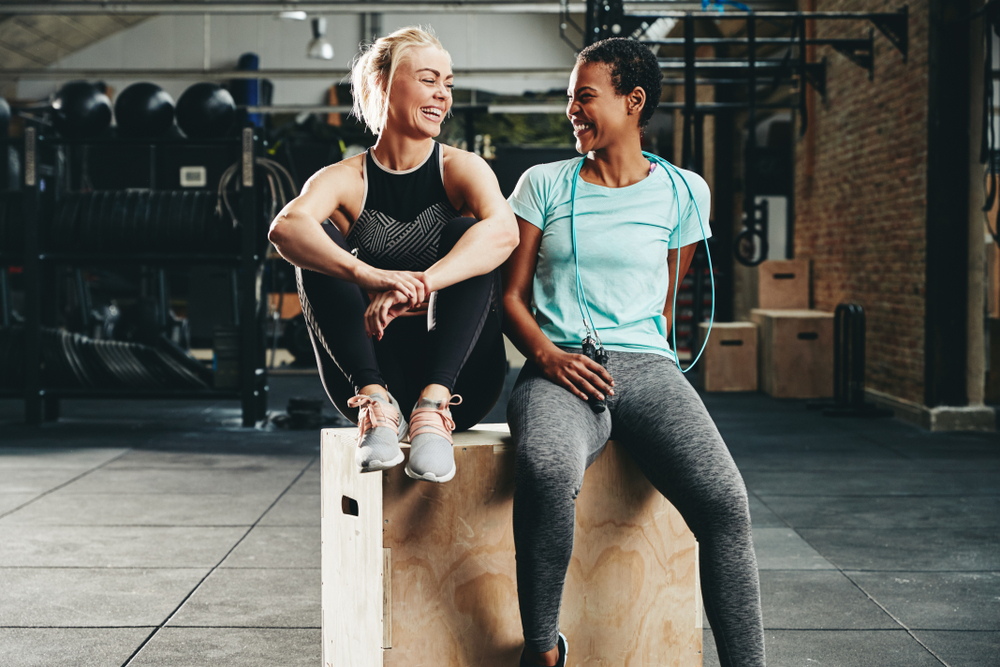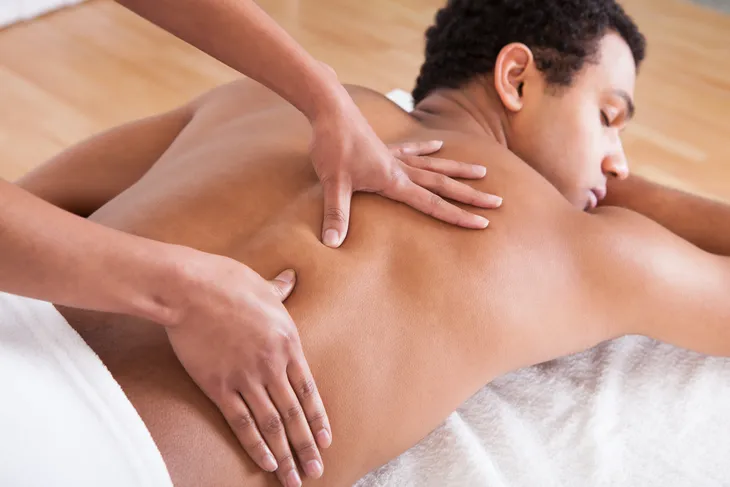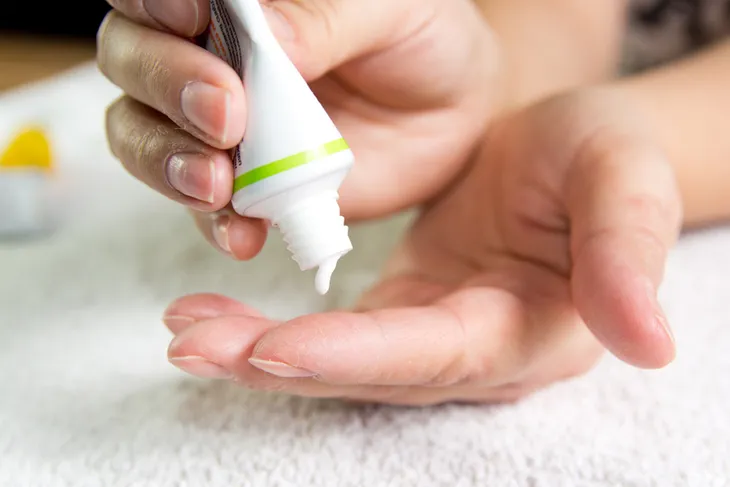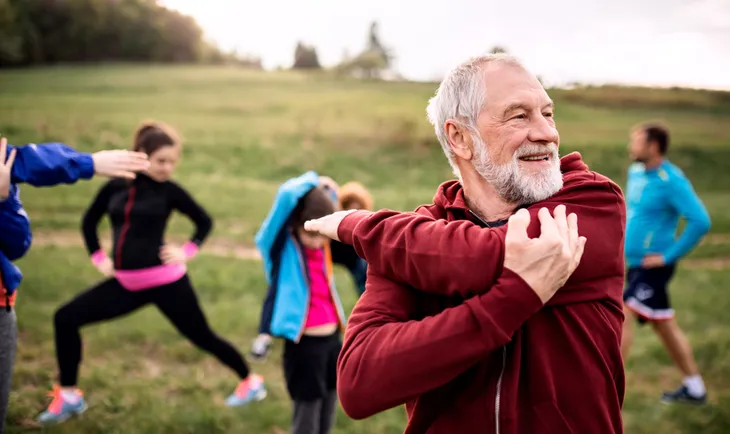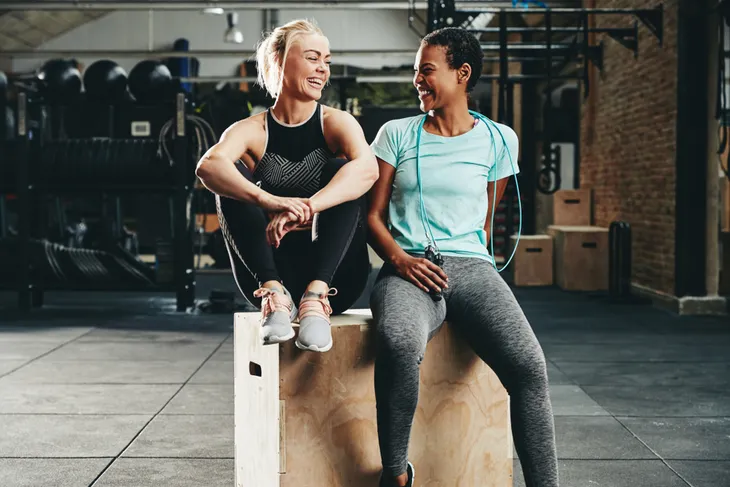- Delayed onset muscle soreness, or DOMS, refers to muscle soreness or stiffness that develops 24- to 72-hours after exercise.
- While it commonly affects beginners or those who haven’t worked out in a while, it can also affect athletes.
- The only way to treat DOMS is time, however, there are strategies you can try to help get some relief.
- DOMS doesn’t usually require a visit to the doctor but if you experience sharp pain, muscle spasms, numbness, or tingling, you should see your doctor as these are not normal symptoms of DOMS.
There’s no better feeling than accomplishing a workout. While working out can be rewarding, it’s not uncommon to experience muscle soreness after, especially if you’re new to exercising. Delayed onset muscle soreness, also known as DOMS, refers to muscle soreness or stiffness that develops within a day or two after exercise.
Many beginners experience DOMS, however, it’s also common in regular gym-goers too. So what causes it and how can you treat it? Follow along to learn more about DOMS.
Signs of DOMS
The telltale sign of DOMS is muscle soreness or stiffness. The American College of Sports Medicine says unlike acute soreness, which happens during the actual exercise, DOMS usually develops 12- to 24-hours after working out. You may also experience “the greatest pain between 24-72 hours after the exercise has been performed,” explains the source.
If you have DOMS, you’ll likely experience achy muscles that are tender to the touch. You may also experience swelling in the muscles, reduced range of motion, and muscle fatigue.
Who Experiences DOMS?
You might think that only beginners will experience DOMS but the fact is, it can affect just about anyone. Healthline says even elite athletes can be affected by DOMS.
Regardless of your level of fitness, DOMS can develop whenever you increase your workout intensity. It can also occur if you perform eccentric exercises (exercises that require slow, lengthening muscle contractions, such as extending your arm during a bicep curl) or new exercises your muscles aren’t used to.
What Causes DOMS?
A common misconception is that DOMS is caused by lactic acid buildup but the American College of Sports Medicine says it’s not actually part of the process. Instead, DOMS is related to “increased stress in muscle fibers as you exert them excessively,” explains Verywell Fit.
Activities that are known to cause DOMS include strength training exercises, jogging, jumping activities, running downhill, deep squats, and push-ups. Essentially, any eccentric exercise that causes you to tense a muscle while you lengthen it can cause DOMS.
How to Treat DOMS
Healthline says the only real treatment for DOMS is time. After a couple of days, your muscles won’t feel stiff or sore anymore. That said, while there is no quick fix or cure for DOMS, there are some treatment strategies you can try to help ease your pain and stiffness.
Treatment may range from active recovery days to gentle stretching, or massage therapy. However, the source does point out that “Research findings are mixed, and more study is needed.” Nonetheless, you can still give these treatment tactics a try and see if they help provide you some relief.
Treatment: Active Recovery
Whenever you experience muscle soreness, your first instinct may be to rest and avoid exercise at all costs. However, Healthline says banishing all movement, and laying on the couch may make your pain and stiffness worse.
We’re not suggesting that you hop on the treadmill for a 10-mile run or engage in an intense power-lifting workout, instead, you can enjoy an active recovery day. This is a technique that includes low-impact exercises such as gentle yoga, walking, cycling, or swimming. You’re still moving your body, but with less intensity. While exercise won’t speed your recovery per se, it may decrease your symptoms. That said, if your muscle soreness is severe, then you should listen to your body and just rest.
Treatment: Cold and Hot Therapy
Your sore muscles may also benefit from cold and hot therapy. Cold therapy involves immersing your body in a cold water bath for 10- to 15-minutes. The temperature is usually about 50- to 59-degrees Fahrenheit (1o- to 15-degrees Celsius). The idea is that the cold water may help reduce inflammation and in turn, help ease pain and stiffness. Healthline says cold therapy is a popular self-treatment for competitive athletes.
In contrast, your muscles may also benefit from hot therapy. This involves immersing your body in a tub of warm water or wrapping your sore muscles in a heat wrap. The heat can help increase blood flow and relax tight muscles.
Treatment: Massage Therapy
In case you need another reason to book yourself a massage, some studies suggest that receiving a massage 24- to 72-hours after an intense workout may help. The research says the “findings demonstrated that muscle soreness rating decreased significantly when the participants received massage intervention compared with no intervention.”
If you don’t have health benefits, paying for massages out of pocket can get expensive. In this case, try giving yourself a massage at home. Try gently massaging the arms, shoulders, calves, thighs, and glutes by kneading and squeezing the area. You can also try using a foam roller post-workout.
Other Treatment Options
There are other methods you can try too that may help relieve muscle soreness, such as topical analgesics. In fact, this study found that menthol-based topical analgesics reduce pain from DOMS. When applying the ointment, be sure to follow the instructions on the packaging.
You may also benefit from eating a diet rich in anti-inflammatory foods, such as olive oil, leafy greens, fatty fish, fruit, and more. While more research is needed to prove that anti-inflammatory foods help DOMS, this study found some evidence.
Finally, you may be tempted to treat sore muscles by taking a pain-relieving medication, however, some research says it doesn’t do much to relieve DOMS.
When to See a Doctor
DOMS doesn’t often require a visit to the doctor and it will usually heal on its own with time. That said, Healthline says you should see your doctor if you develop DOMS from normal daily activities.
You should also contact your doctor if your DOMS lingers for more than 7-days or if you have severe swelling in your arms and legs. The source also says if your urine becomes abnormally dark, then you should also visit your doctor.
Finally, it’s vital to differentiate between DOMS and sharp muscle pain as they’re not the same. Sharp pain, muscle spasms, numbness, or tingling are not normal symptoms of DOMS and should be checked out by a doctor.
Can DOMS Be Prevented?
Unfortunately, there isn’t a proven formula to prevent DOMS entirely. That said, you may be able to reduce its intensity by following a few tips. For starters, when working out, always stay hydrated. This study found that men who exercised in hot, humid climates saw a decrease in muscle soreness when they drank water before, during, and after their workout.
It’s also a good idea to warm up before your workout with dynamic stretches that open up and warm the muscles. After intense exercise, you should also do a cool down to bring your heart rate back to normal and finish with some static stretches. Finally, to help reduce the severity of DOMS, take your workout routine slowly, and don’t try to jump intensity or weight too quickly. Over time you’ll build strength and endurance, which in turn, can reduce the effects of DOMS after each workout session.
Is DOMS an Indicator of a ‘Good’ Workout?
How much truth does the popular saying, ‘no pain, no gain’ actually hold? If you think feeling sore is a good indicator of a ‘good’ workout, the answer is, unfortunately, no. DOMS is merely a side effect of the repair process that occurs when your muscle fibers become damaged.
Over time, as you gain strength and endurance, your muscles will become less sore after your workout. But that doesn’t mean you’re not working out hard enough, or that you’re not gaining anything from that workout. In fact, the American College of Sports Medicine says, “pain does not need to be present to achieve gains in fitness status, and pain may indicate a need to reduce or refrain from an activity.”
The Takeaway
While DOMS can be uncomfortable, you shouldn’t let it hold you back or prevent you from exercising for fear that you’ll develop it. As we mentioned, over time as your body builds strength and endurance you’ll experience less soreness after working out.
If you develop DOMS, take the steps we outlined above to see if they help ease the soreness. Remember to seek medical care if you experience sharp pain, numbness, or tingling. Finally, the American College of Sports Medicine recommends getting clearance from your doctor before starting any new exercise program.
